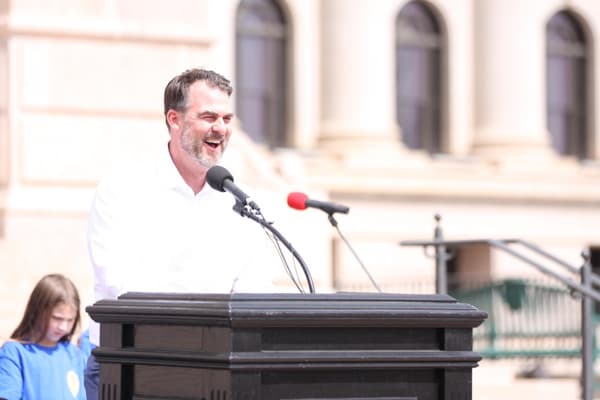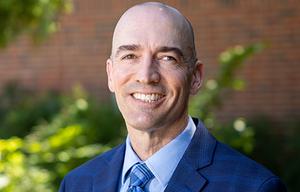
Higher Education
Stitt opposes college tuition increases
Ray Carter | June 5, 2025
With this year’s legislative session concluded and more than $1 billion in state appropriations provided to Oklahoma’s public colleges and universities, Gov. Kevin Stitt said he believes the state’s major universities have no reason to hike tuition.
“My gut feeling is, no, we don’t need a tuition increase at this point,” Stitt said at a press availability. “I don’t think we’ve gotten all of the efficiencies out of our universities, so I would encourage the boards to continue to look for efficiencies, look for the professors—the tenured professors—that maybe aren’t teaching as many classes as they should. So those are the things that I would continue to push before they did a tuition increase.”
If college officials do not increase tuition, it will buck a longstanding trend of rapidly rising tuition rates, even as state funding for colleges has also increased.
According to the U.S. Bureau of Labor Statistics, the price of college tuition/fees increased by 1,518 percent from 1977 to 2024. During that time, college tuition experienced an average inflation rate of 6.1 percent per year, which is far higher than the overall inflation rate of 3.56 percent during the same period. As a result, to receive the equivalent education that $20,000 in college tuition provided in 1977, a student had to pay $323,763 in 2024.
“I don’t think we’ve gotten all of the efficiencies out of our universities, so I would encourage the boards to continue to look for efficiencies.” —Gov. Kevin Stitt
A Nov. 14, 2024, report by Andrew Gillen, research fellow at the Cato Institute’s Center for Educational Freedom, reviewed state funding for colleges in all 50 states from 1980 to 2023 and concluded that “state disinvestment is a myth.” The report said the trends “disprove the common argument that tuition has been rising over the past several decades to offset cuts in state funding.”
The Cato report estimated that state funding for Oklahoma colleges has dropped only $2 per student since 1980, although funding has fluctuated in line with state economic activity, declining slightly during downturns before rebounding in times of economic growth.
At the same time, the report showed college tuition steadily increased from 1980 to 2023, even after adjusting for inflation. As with most states, Gillen found that tuition increases in Oklahoma far outpaced changes in state funding for colleges and universities.
The Wall Street Journal found that between 2002 and 2022, enrollment at the University of Oklahoma increased by 15 percent, but tuition increased by 36 percent, even after adjusting for inflation. Once student fees were included, the combined rate of growth was even more dramatic and was the highest in the nation.
“At the University of Oklahoma, per-student tuition and fees rose 166%,” the Journal reported, “the most of any flagship.”
Notably, officials at OU have begun prioritizing the recruitment of out-of-state students, who pay higher tuition than Oklahoma residents, as part of an effort to boost university revenue even further.
“At the University of Oklahoma, per-student tuition and fees rose 166%, the most of any flagship.” —The Wall Street Journal
In the 2024-2025 school year, a majority of freshmen students at the University of Oklahoma were not from Oklahoma, accelerating a trend that has been ongoing for several years.
While more Oklahomans are attending OU than in the past, the school’s enrollment growth over the last decade has been primarily the result of out-of-state students. While such students are common at universities across the country, it is unusual for nonresident students to comprise a majority of freshmen enrollees at a state school, based on publicly available information from several schools in the region.
While Oklahoma’s colleges received increased state appropriations this year, the budget requests submitted by college officials indicate they have an appetite for far larger amounts, perhaps signaling bad news for parents hoping tuition rates will be kept flat for at least one year.
This year, state college officials requested a 46 percent increase in state appropriations. Lawmakers and the governor instead chose to increase college funding by 7.29 percent, providing $1.1 billion in funding to Oklahoma’s colleges and universities.
[For more stories about higher education in Oklahoma, visit AimHigherOK.com.]

Ray Carter
Director, Center for Independent Journalism
Ray Carter is the director of OCPA’s Center for Independent Journalism. He has two decades of experience in journalism and communications. He previously served as senior Capitol reporter for The Journal Record, media director for the Oklahoma House of Representatives, and chief editorial writer at The Oklahoman. As a reporter for The Journal Record, Carter received 12 Carl Rogan Awards in four years—including awards for investigative reporting, general news reporting, feature writing, spot news reporting, business reporting, and sports reporting. While at The Oklahoman, he was the recipient of several awards, including first place in the editorial writing category of the Associated Press/Oklahoma News Executives Carl Rogan Memorial News Excellence Competition for an editorial on the history of racism in the Oklahoma legislature.